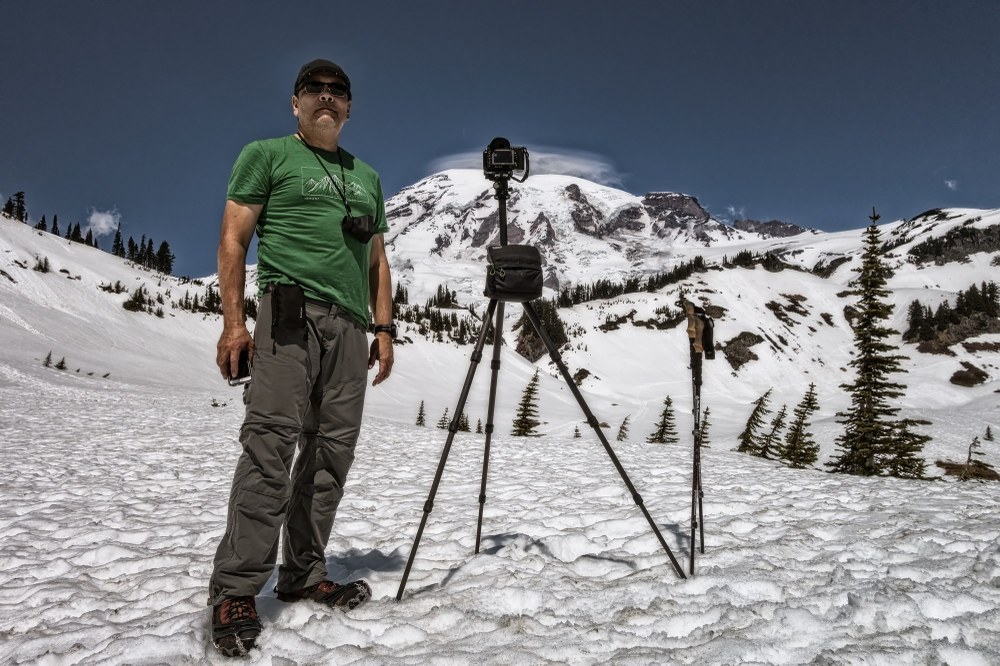
During my previous life as a sportswriter, an NBA player once made me wait for an arranged interview while he horsed around with ball boys in front of his locker. After a long spell of this, he grew bored and finally turned to me.
“I don’t talk to no f***ing white boys,” the player said.
“What if I’m not white?” I replied.
“Then what are you?” he asked.
“Japanese,” I answered.
“I don’t talk to no f***ing Japs neither,” he said.
I wouldn’t have admitted it to that player, but there is a part of me that is white. But I rejected most of it long ago. Except for the place my father fills, my whiteness has been replaced by the rest of me: The son of a Japanese immigrant, the father of two daughters more multiracial than I am, the husband of a daughter of South American immigrants, the uncle of a Korean adoptee. I’m also a journalist who has received death threats – among them: “If you love Japan so much, we’re happy to send you back in a pine box.” That’s because in the 1990s I supported a Muslim basketball player who refused to stand for the national anthem because of the way his people, and mine, were oppressed in this country.
I’m also male and a Baby Boomer. I have a white name. When I tell people I have a Japanese parent, you’d be surprised by how many ask me which one.
Being multiracial has given me a chameleonic nature, making it mostly easy to move between races. Still, sometimes I feel like I’m perpetually stuck between here and there, my inbetweenness both my paradox and my identity. Sometimes people don’t know what to make of me, or in what language to address me; occasionally, they think they know me because I look like a bit like everybody. Sometimes I get let in on unpleasant secrets, as when I inquired at city hall in the coal-mining town of Benham, Kentucky, about the childhood neighborhood of its most prominent citizen, Bernie Bickerstaff, an African American NBA coach. “You’re looking for N*****town,” I was told with staggering nonchalance.
Ted Turner once hired me to write his autobiography and flew me to his ranch in Montana. There, I stood in the middle of the continent’s largest bison herd as it wandered through what was essentially Turner’s front yard. Turner screamed at me to run for the house: “Those f***ers will kill you!” But what I remember most was what he told Jane Fonda, whom he’d recently started dating. Although I was at the opposite end of Turner’s ranch house, I could hear him, in full Mouth of the South mode, tell her on the phone, “I have Glenn Nelson over here. You’d love him; he’s eth-neek.”
I've always identified as Japanese or Asian American. For most of my life, I thought I did so because of my mother. And when Samurai movies or sushi or even reliable, fuel-efficient cars became vogue in the U.S., it was cool to be Japanese. But the gritty core of my identity was forged long before that, when my parents, Chiyoko Abe and Scott Nelson, started courting in Niigata, in snow country on the northern part of the Japanese main island of Honshu. My father was stationed there with the U.S. Air Force during the Korean War.
When my parents decided to marry, my father had to secure permission from the Air Force. That meant my mother had to undergo a background check. There also were medical exams and meetings with a chaplain. The process became even more protracted when my father wrote his mother to reveal his plans to marry a Japanese woman. Alarmed – this was the ’50s, remember – she telegrammed my father’s commanding officer. That’s how my father came to be re-assigned to Sado Island for seven months, to “think things over.” Sado is so remote that, throughout Japanese history, it was a place to which the enemies of ruling clans were exiled. My father emerged from his own exile still resolute. This year, my parents celebrated their 60th wedding anniversary.
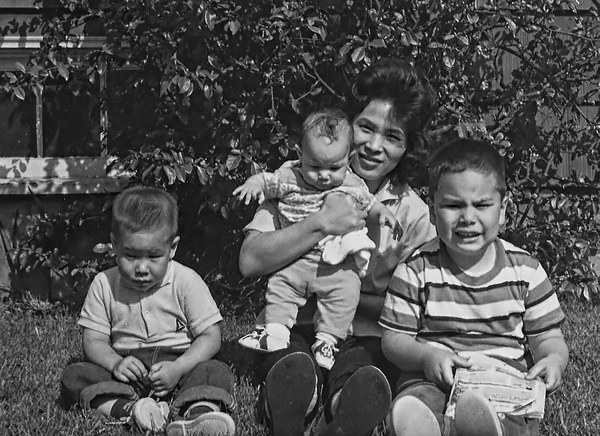 Glenn Nelson with his mother and siblings, Mike and baby Linda. Photo courtesy of Glenn Nelson.
Glenn Nelson with his mother and siblings, Mike and baby Linda. Photo courtesy of Glenn Nelson.
Early in those 60 years, people called my mother a “dirty Jap” in public. More than once I tried to scrub the “dirty” color out of my own skin. I remember the underlying hostility with which the other women in my father’s life treated my mother. She endured it, per cultural prescription, and eventually forgave my grandmother and aunt, both of whom have since passed. I never came to grips with that. If you’re Asian, you have a dichotomous outlook that maybe only your Catholic and Jewish friends recognize: The guilt you feel about doing something wrong, but the shame you feel when it is you who have been wronged. It’s often hard to distinguish the two. So I’ve come to understand that, even as I have embraced being Japanese, I have deliberately rejected being white because of the guilt over what my white family did to my Japanese mother, and the shame I still feel over watching it happen.
Sometimes I imagine Teddy Roosevelt and John Muir at the top of Glacier Point in Yosemite National Park, discussing the preservation of wild places, but never imagining someone like me at any of them. I imagine a different Roosevelt signing Executive Order 9066, sending people like me to wild places for the preservation of a national identity – an identity that, well past World War II, dealt people of Japanese descent out of the equation. I imagine another president signing another law that excludes the Chinese in my daughters.
I also imagine, in two or so decades, belonging to a nonwhite majority whose ancestors were hanged from trees, forced to labor in fields, or, if not slaughtered outright, forcibly relocated from the best wild lands to the worst. I imagine that nonwhite majority deciding that it doesn’t give a frack about fracking, a crap about climate change, or even rubbing two sticks together to spark an environmental revolution. I imagine “the planet” appearing as an alien construct, the white man’s conceit, and not ours to save.
Then I imagine my children and my children’s children – those multiracial, multicultural generations – not understanding why we allowed it all to just burn, baby, burn.
And so I imagine changing the picture, before it’s too late.
If I rewind to my youth, the picture improves in some ways. I think of early mornings fishing with my mom and dad, days on trails and shores, and nights in sleeping bags under stars. My father was my scoutmaster at Troop 14 in Seattle. That is where I met one of my oldest friends, Gordon McHenry, Jr., who is African American and now the head of a prominent anti-poverty organization. Our fathers liked to walk and take pictures, and I now follow in their footsteps. My brother, Mike, also was a Boy Scout, as was Gordon’s brother, Eric. And there were other black, Asian and Native kids in Troop 14. Being a person of color in the outdoors seemed perfectly normal.
College was where I first began to understand that people like us were outliers. At Seattle University, Gordon and I practically dragged our classmates of color outside. We abided the nervous tension in car rides to what our friends called “the woods,” whether or not trees were present. Someone inevitably joked about being lynched. David Black, who actually is black, would hum the theme from Deliverance, which instantly registered as the racist national anthem. This outlook was alien to me – the fear and loathing expressed by brothers from another planet. But I came to understand that the planet where race is such a persistent touchstone is my planet, too. I did my graduate work in American government at Columbia University, where I studied under Charles V. Hamilton, co-author of the seminal 1967 book Black Power: The Politics of Liberation. I frequently went to Harlem, to do research at the Amsterdam News offices and election archives. And I stayed connected to one of my life’s passions – basketball. Some would say I double-majored in hoops because I spent so much time in the gym with cats from Harlem like my buddy, Jesus (who, when I asked his last name, told me, “the Messiah”). I went to Madison Square Garden to watch an all-black NBA team that was pretty overtly referred to as the “N*****bockers.” On a student’s budget, I bought upper-level tickets, with plans to move closer to the court as the arena’s crowd inevitably thinned. In the upper reaches, drugs were hawked like sodas and hot dogs. A dealer once thrust a joint in my face and claimed, “I got the shit that killed Bruce Lee” – an attention-grabbing declaration to someone who hails from Seattle, where Lee is buried.
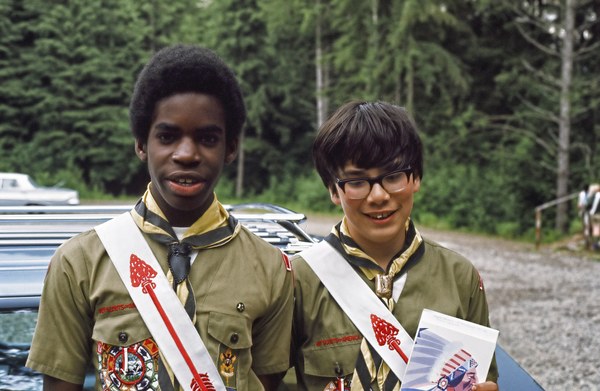 Glenn Nelson with Gordon McHenry, Jr., now the head of a prominent anti-poverty organization, during their days with Boy Scout Troop 14 in Seattle. Photo courtesy of Glenn Nelson.
Glenn Nelson with Gordon McHenry, Jr., now the head of a prominent anti-poverty organization, during their days with Boy Scout Troop 14 in Seattle. Photo courtesy of Glenn Nelson.
Then I got an offer to work for The Seattle Times, a newspaper I once delivered to finance tickets for the SuperSonics. It was a no-brainer; my high-school yearbook contains entries like, “Looking forward to reading your Sonic stories in The Seattle Times.” And, as much as my Columbia classmates gave me the Bronx cheer for “selling out,” my study of race in America actually accelerated in the sports arena.
In sports, it rarely mattered that I wasn’t white. At times, it was a virtue. Then considered too black and a “drug league,” the NBA served my interests by opening up to the media and reshaping itself as the purview of captivating individuals. In the back of team buses, I talked to Dale Ellis, Xavier McDaniel and Nate McMillan about growing up in the South, or Sam Perkins and Kevin Williams about life in East Coast inner cities. Sometimes discussions of black conservative politics took place in the front of the bus, over the Wall Street Journal, with people like the late Maurice Lucas, with his Enforcer persona and teddy bear personality. I once toured East Oakland’s ironically named gang and drug-infested High Street with one of its favorite sons, Gary Payton, then barely an NBA rookie. A few years later, we toured Payton’s multimillion-dollar home in the tony hills above Oakland, replete with a bowling alley and Asian-styled spa with a retractable roof.
“Glenn knows what time it is,” Payton once told a journalist competitor of mine, a reference to my “being down” with athletes of color and their culture.
I also knew the time in South Korea, one of the only places I’ve visited, besides Japan, where my ancestry was instantly recognized. I’d fretted about that when I covered the Summer Olympics there, given the strained historical relationship between the two countries. So I brought gifts and a cool pair of sunglasses, both of which delighted the young soldiers who, in plain clothes, secured the Olympic Village.
“You are our favorite journalist, even if you are a Japanese,” one of them told me, cheerfully.
“But if we ever find a Korean girl in your room,” he added ominously, “we will not hesitate to shoot you.”
My Globetrotting abated when, in the late 1990s, I left newspapering for a thing called the internet. The web was liberating. I was a words guy at The Seattle Times, but soon began using audio, video and, most of all, photography to expand my storytelling repertoire. Developing HoopGurlz, a national website dedicated to empowering young women through basketball, I believed that women relate to sports more visually than men do, so I began carrying cameras in addition to pads and pens.
I left ESPN, to which I sold HoopGurlz in 2008, with a nagging feeling that my success as a photographer was due more to my basketball acumen than skill: I knew where to point the camera. A friend, Paul Bannick, who is an owl expert, turned me on to wildlife photography. Soon I was regularly hiking and photographing, mostly in national parks. When my knee got repaired, I had to temporarily forego dragging big lenses into the field, so I took smaller ones and got hooked on landscape photography. This revived my love for the outdoors, which had been sparingly nurtured by birding forays and outings with my daughters, Sassia and Mika.
Two years ago I read a story in The New York Times about the lack of diversity in National Park Service visitation. “You’re always talking about that!” said my wife, Florangela, whom I married in Tofino, just outside Pacific Rim National Park in British Columbia. She suggested I write an op-ed piece about it for the Times. It was a good idea, but I reminded her that those pieces always end with a biographical line regarding current projects – and I didn’t have one yet. Researching the op-ed, I found that diversity was a major problem not just for national parks, but for the whole outdoors sector, which was overwhelmingly white and aging out as the nation’s demographics changed. The issue dovetailed neatly with my growing concern for the state of the planet I was leaving my girls. I started The Trail Posse to document and encourage diversity and inclusiveness in the outdoors.
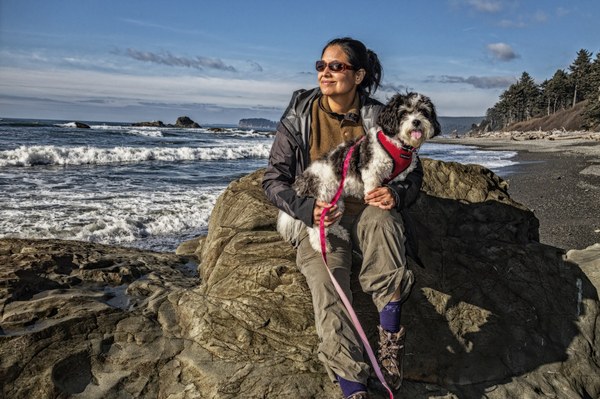 FLORANGELA DAVILA, GLENN’S WIFE WITH THEIR DOG SANTANA ON WASHINGTON COAST. PHOTO BY GLENN NELSON.
FLORANGELA DAVILA, GLENN’S WIFE WITH THEIR DOG SANTANA ON WASHINGTON COAST. PHOTO BY GLENN NELSON.
My piece, “Why are our parks so white,” published by The New York Times last summer, was a booster rocket for The Trail Posse. Thousands of comments, both pro and (some very nasty) con, were posted on every web platform of the Times, as well as on other social-media channels. My inbox overflowed, and it hasn’t stopped since.
My life changed dramatically. I’ve had to surmount other barriers – psychological ones. I am afraid of heights, but a little over a year ago, I drove myself for the first time ever to Paradise in Mount Rainier National Park, elevation 5,400 feet, something I would never have done even as a passenger a year earlier. Recently I drove and hiked all over Rocky Mountain National Park, though I was glad that Trail Ridge Road, at 12,183 feet, still was closed. Last fall, I overcame another fear: public speaking. I presented before an almost all-white banquet crowd at the National Wilderness Workshop in Missoula, Montana, and did another talk for a large nonprofit called Forterra at Town Hall in Seattle. A few months ago, I partnered with an otherwise all-white staff at High Country News, which has become the first major media outlet to commit to regularly covering race, diversity and inclusion in the outdoors.
I’ve discovered that I’m not alone. I’ve met dozens of people who are focused in some way on the connection between diversity in the outdoors and the mounting environmental crisis. This nascent movement inspired us to create the Next 100 Coalition. It’s composed of diverse leaders from civil rights, environmental justice, conservation and community organizations that has called on the Obama administration to take tangible steps toward creating an inclusive system of national parks and other public lands that reflects, honors and engages all Americans.
This whirlwind period of my life has reinforced the idea that I don’t have to be white to be green. Race and the outdoors are tethered concepts for most of my generation; the Civil Rights Act and the Wilderness Act both were signed in 1964. It’s difficult to comprehend how we ended up in a place so disconnected.
I've met white seniors on trails who’ve patted me on the head for “doing a good job of assimilating,” in essence thanking me and other nonwhites not for joining their ranks, but for becoming invisible. “Inclusion isn’t about assimilation,” according to my friend Carolyn Finney, author of Black Faces, White Places. In the natural world, we call it checking our identities at the trailhead. Which means we get questioned for hiking in groups, something white people apparently find intimidating, though many of us do it to feel safer around them. It means having trouble getting a permit for a big-enough camping spot because our outdoors party, especially if we’re Latino, might comprise all of our familia, including our abuelos and other extended members. It means getting shushed for socializing on the trail, something I’ve never heard anyone do to, say, a chatty group of white female hikers. Shoot, inclusion isn’t even about inclusion, which is by definition adding something different to an otherwise sameness. It’s about embracing – and recognizing – who already belongs.
Growing up, we chided each other to “act your race,” and, ever so slowly, we’re giving ourselves permission to do just that. It’s been a struggle. One of the more traumatizing incidents of my youth was going back to Japan for the first time with my mother when I was 16. I was allowed to return to the U.S. only if I first renounced my Japanese citizenship, to which I was entitled because I was born on a U.S. Air Force base in Tokyo. How do you renounce part of yourself? It’s like cutting off a body part. Yet people of color have been asked to perform cultural amputation for centuries. I was taught, largely by white educators, that being American was celebrating differences — which feels in retrospect like celebrating shades of (male) whiteness, from St. Patrick to Columbus and all the presidents who have their day. Pride — in country, flag and the majority culture, whatever that is — is encouraged, unless it’s associated with ethnicity, sexual orientation or gender. If we have to keep checking all of that at the trailheads, there won’t be space for restrooms, drinking fountains, or parking.
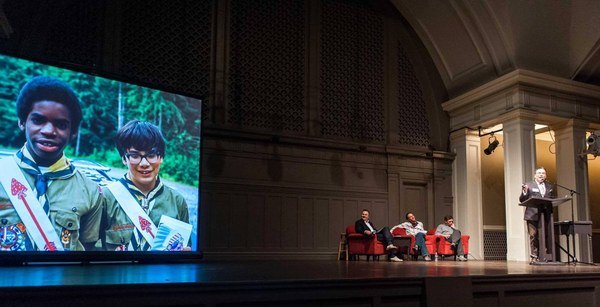 GLENN NELSON PRESENTS FOR FORTERRA AT AMPERSAND LIVE AT TOWN HALL, SEATTLE, NOVEMBER 2015. PHOTO COURTESY OF GLENN NELSON.
GLENN NELSON PRESENTS FOR FORTERRA AT AMPERSAND LIVE AT TOWN HALL, SEATTLE, NOVEMBER 2015. PHOTO COURTESY OF GLENN NELSON.
Because the outdoors remains a largely white domain, it is up to white America to invite communities of color in, to enlist us as allies. And it needs to happen across the governmental, nonprofit and business ecosystem if we have are to have a chance at retaining our public lands and creating a sustainable planet.
To come for us, white America cannot roll out the same tactics it frequently has deployed against us. It cannot continue to portray race as purely black and white. It cannot adopt us, as if we were mascots, and, in best checkboxist fashion, isolate, tokenize, and ultimately co-opt us. We’re to be activated, not neutralized. People of color need to be at the table, in workforces and budget-line items. To have real power. A group of white people can no more decide on its own how best to attract and convert people who are not like them than older people can for Millennials, or men for women, or straights for LGBTQ. And we have to break the cycle of what I call Summer Camp Syndrome, where we come together, have a “good talk,” feel connected and pledge unending devotion, then go home and allow the sentiment to fade into inaction.
When disheartened, I find inspiration from my immigrant mother and immigrant mother-in-law. As naturalized citizens, they see public lands differently, much like new members of a club with “ownership of iconic landscapes” among the benefits. My mother-in-law, Ligia, literally wants to cart off parts of “her parks” – a rock, leaf or tronquito (branch) – and still gets disappointed when I stop her because it’s against the law. The mothers help me believe that lost passion for the outdoors is reignitable in those much longer rooted in this country.
As new stewards, we have new outlooks, often unchained to custom and convention. Last fall, I spoke at the National Wilderness Workshop, whose organizers explained that “wilderness” is a higher, more complicated designation than, say, national parks, where I’d done most of my work. Because the mostly beginner-level audience I am seeking does not need additional complexity, I challenged myself to plot an elementary course from urban dwelling to wilderness. My own home provided a starting point.
My wife, Florangela, is a Latina from Los Angeles, whose mother is from Colombia and father from Peru. She long has loved the sea, but I have encouraged her growing enchantment with forests, mountains, rivers and lakes. When we bought our first house, I hung a bird feeder from our balcony. We soon had regulars, primarily northern flickers. We delighted in them, even named them. We took classes to learn how to create native habitat, as well as identify other species. We bought a pair of binoculars and ventured into local parks, then into state and national parks and wildlife refuges. I bought a spotting scope to entice my youngest daughter, Mika, who has special needs that preclude the use of other optics. We took her older sister, Sassia, to Canada to look at snowy owls.
When we left that first house, Florangela wept, distressed about the fate of “Flicky” and its family. But we’ve attracted northern flickers and many other birds to every place we’ve moved. Now, her mother has a vast network of feeders in the backyard of her house.
All of that unfolded from a simple act: Stepping outside our home and looking into the sky, seeing creatures and patterns that now cannot be unseen, the life connecting us thousands of miles away to places, even wilderness, and people who share our outlook and maybe even look like us.
It’s not a cure for this ailing world. It may not even be a saving grace. But it’s something – something that makes me believe it doesn’t matter if I’m not white. I still count, and will have my say.
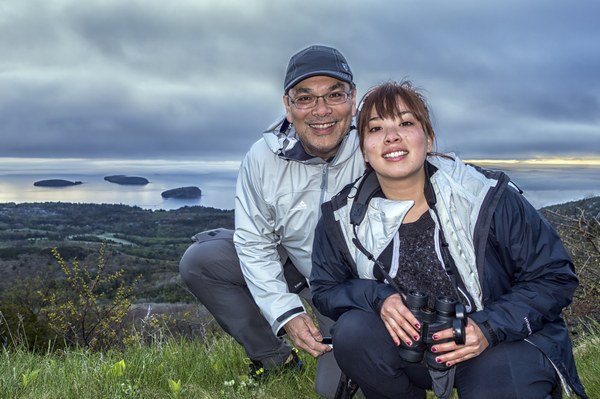 Glenn Nelson and his daughter Sassia on Cadillac Mountain in Maine’s Acadia National Park. Photo courtesy of Glenn Nelson.
Glenn Nelson and his daughter Sassia on Cadillac Mountain in Maine’s Acadia National Park. Photo courtesy of Glenn Nelson.
Glenn Nelson is the Seattle-based founder of The Trail Posse, which in partnership with High Country News covers race, diversity and inclusion in the outdoors. Read more at trailposse.com.
This article originally appeared in our Fall 2016 issue of Mountaineer Magazine. To view the original article in magazine form and read more stories from our publication, click here.
Add a comment
Log in to add comments.This essay is the best thing I've read in the Mountaineers. Glenn Nelson truly "knows what time it is". His writing will hopefully help the rest of us learn what time it is as well.
I found this to be a rare and refreshing piece and thank the author for his courage in writing it. We should take solace that white people are now heading into their third generation of declining birthrates and very rapidly increasing intermarriage with people of color. When you add to that the enormous rate of diversity arriving into the US, Australia, and Europe, it won't be long, perhaps another three generations, until white people will be utterly and permanently outnumbered anywhere on the planet. Unfortunately, I doubt I'll be around to experience it, but it will be about time, frankly. White supremacy has been a reign of terror for hundreds of years and has brought nothing but anguish to countless millions of defenseless people of color around the planet. Its time is almost up, and we should all be thankful!
 Glenn Nelson
Glenn Nelson